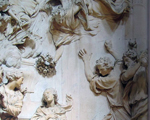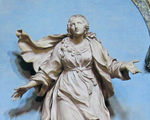ERCOLE FERRATA
Ercole Ferrata (1610 – 1686) belongs to that "Tribe" from Ticino, who exalted the Roman Baroque.
Ferrata, after a long and painful apprenticeship in Genoa, Naples and l’Aquila, arrived in Rome in 1647. Here he was influenced by the classicism of Algardi and Duquesnoy, then walked over to Bernini, in this way he developed a style that epitomizes the fantasy of Bernini with the composure of Algardi.
His main works can be seen at Sant’Agnese in Agone where there are the marble reliefs with the martyrdom of Santa Emerenziana, St. Agnes at the stake and the martyrdom of Saint Eustace, that his pupil Melchiorre Caffà who died suddenly, had left unfinished.
 |
 |
 |
 |
| Ferrata at Sant’Agnese in Agone -
click to enlarge |
In Santa Maria sopra Minerva Bernini entrusted him the sculptures of Cardinal Pimentel, Faith and Wisdom, while in the same church Carlo Rainaldi entrusted him the memorial of Cardinal Bonelli.
On the façade of Sant'Andrea della Valle of his hand are the statues of St. Andrew, di St. Andrew Avellino and the angel who stands on the second order of the façade.
In the church of Jesus and Mary he has sculpted the splendid tomb of Julius del Corno.
 |
 |
 |
| The tomb of Julius del Corno -
click to enlarge |
In Santa Maria dell’Anima do not miss the bust of Cardinal Sluse.
In the Falconieri chapel of St. Giovanni dei Fiorentini, designed by Borromini, he carved the statue of the Faith.
At St. Augustine one can see the great eternal Father and the group of Charity, started by his pupil Melchiorre Caffà and left unfinished, as we remembered for his sudden death.
In the Spada chapel, designed by Borromini, at San Girolamo della Carità, he carved the statue in memory of Lorenzo Spada.
Finally was influenced by Bernini his Santa Anastasia, in the homonymous church, certainly inspired by the Berninian Blessed Albertoni. Relevant, however, the incredible ability of Ferrata in working the marble and the dramatization expressed by the right hand of the saint.
>> A BIT IN DEEP
back |

